The Radeon HD 7970 Reprise: PCIe Bandwidth, Overclocking, & The State Of Anti-Aliasing
by Ryan Smith on January 27, 2012 4:30 PM EST- Posted in
- GPUs
- AMD
- Radeon
- Radeon HD 7000
Overclocking Revisited
While we’ve taken a look at overclocking the Radeon HD 7970 in our review of XFX’s Radeon HD 7970 Black Edition Double Dissipation, that was a look at XFX’s custom cooled card. We’ve had a number of requests for overclocking performance on our reference card, so we’ve gone ahead and done that.
In the meantime though a couple interesting facts have come to light. While both our reference card and our XFX card ran at 1.175v, it turns out that this is not the only voltage the 7970 ships at. Retail buyers have reported receiving cards that run at 1.112v and 1.05v, and Alexey Nicolaychuk (aka Unwinder), the author of MSI Afterburner, has discovered that there’s a 4th voltage according to the fuses on Tahiti: 1.025v. 1.025v has not been seen in any retail cards so far, and it’s most likely a bin that’s reserved for future products (e.g. the eventual 7990), while out of the remaining 3 voltages 1.175 appears to be the most common.
| Radeon HD 7900 Series Voltages | ||||
| Ref 7970 Load | Ref 7970 Idle | XFX 7970 Black Edition DD | ||
| 1.17v | 0.85v | 1.17v | ||
In any case, in overclocking our reference 7970 we’ve found that the results are very close to our XFX 7970. Whereas our XFX 7970 could hit 1125MHz without overvolting, our reference 7970 topped out at a flat 1100MHz. Meanwhile our memory speeds reached 6.3GHz before performance began to dip, which was the same point we reached on the XFX 7970 and not at all surprising since both boards use the same PCB.
Overall this represents a 175MHz (18%) core overclock and 800MHz (15%) memory overclock over the stock clocks of our reference 7970. As we’ll see, since this is being done without overvolting the power consumption hit (and all consequences thereof) from this is minimal to non-existent, making this a rather sizable free overclock.
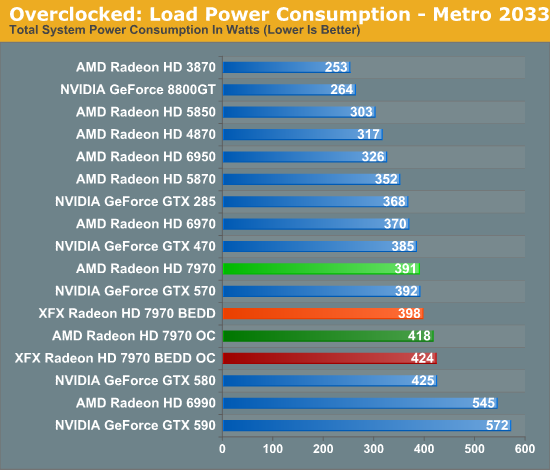
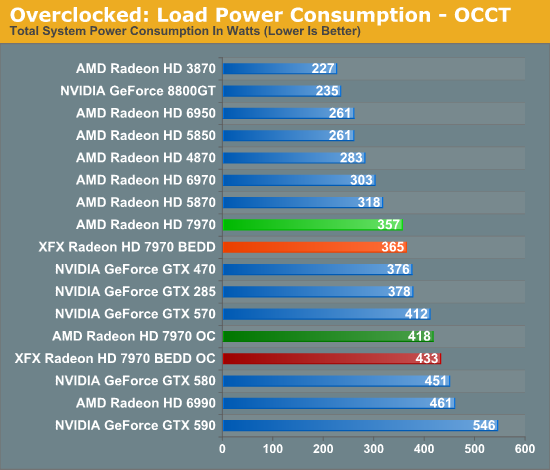
Taking a quick look at power/temp/noise, we see that the increase in load power is consistent with our earlier results with the XFX 7970. Under Metro the power increase is largely the CPU ramping up to feed the now-faster 7970. While under OCCT we’re seeing the consequence of increasing the PowerTune limit so that we don’t inadvertently throttle performance when gaming.
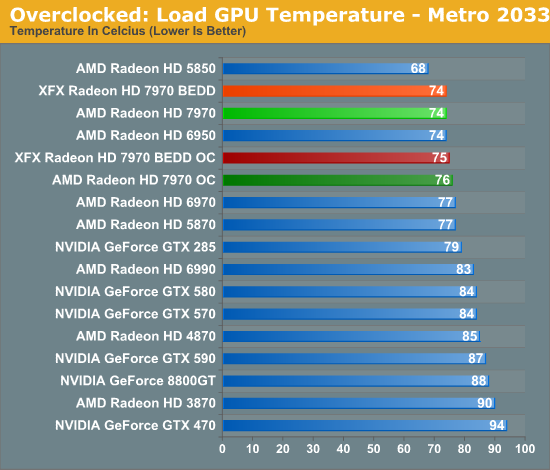
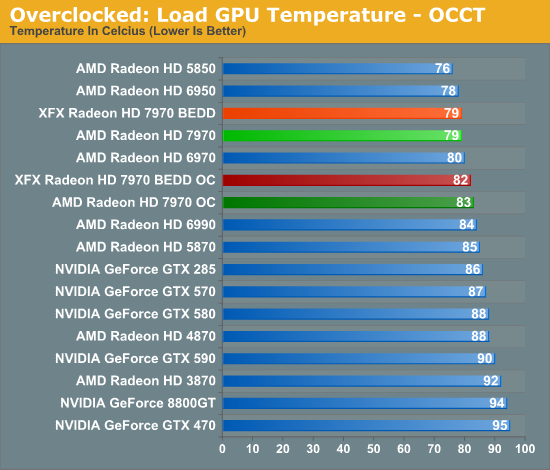
With almost no increase in GPU power consumption while gaming, temperatures hold steady. This translates to a 2C increase in temperatures, while under OCCT the difference is 4C.
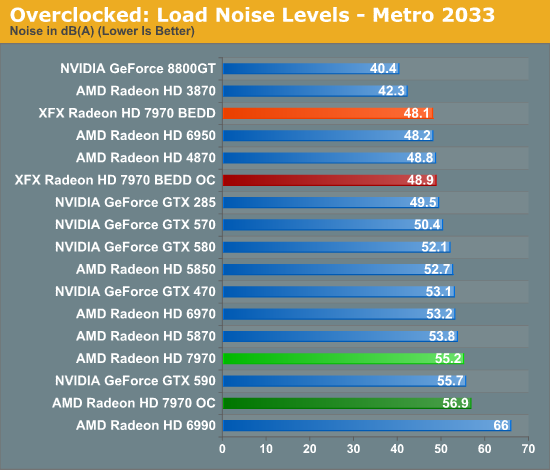

Finally, as with temperature, noise only ever so slightly creeps up. Unfortunately for most users, AMD’s already aggressive fan profile makes this relatively loud card just a bit louder yet; the temperatures are fantastic, but the noise less so. Things look even worse under OCCT, but again this is a pathological test with PowerTune increased to 300W.
Meanwhile gaming performance is where you’d expect it to be for a card with this degree of an overclock. As most tests scale very well with the increase in the core clock virtually all of our games are 15-20% faster over a reference 7970. Whereas compared to the XFX 7970, at 98% of the XFX 7970’s overclock, our overclocked reference 7970 is only a couple percent behind the XFX card and barely outside the margin of error of most tests.
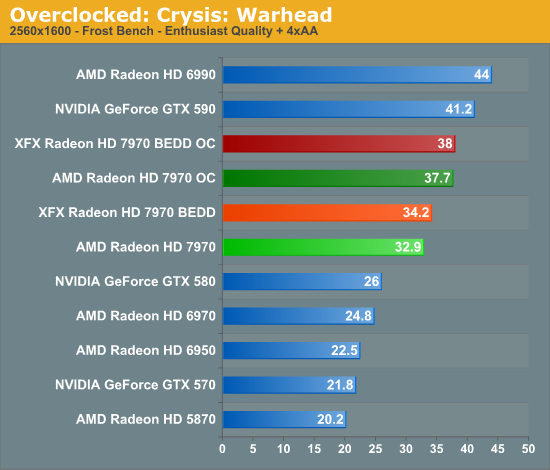
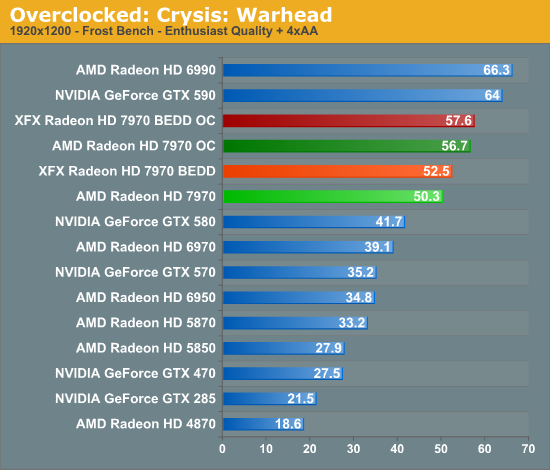

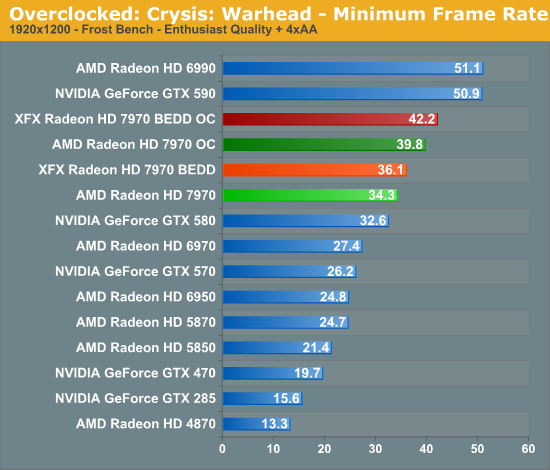
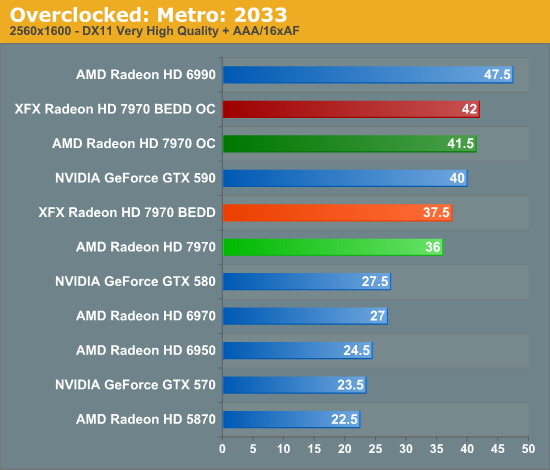

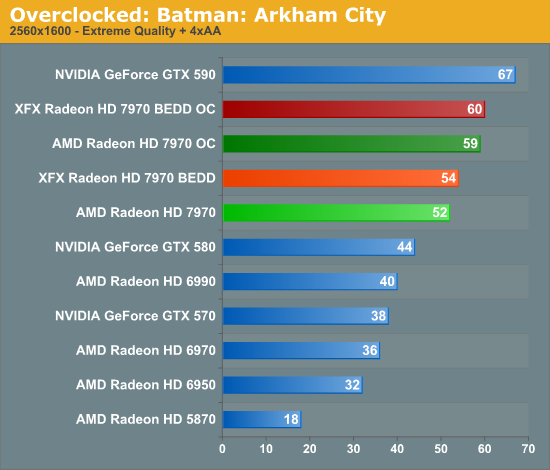
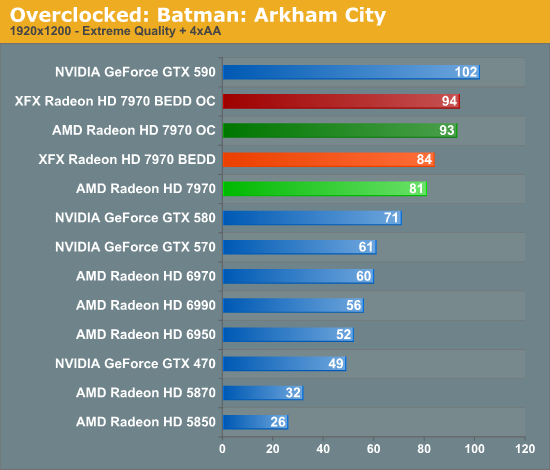
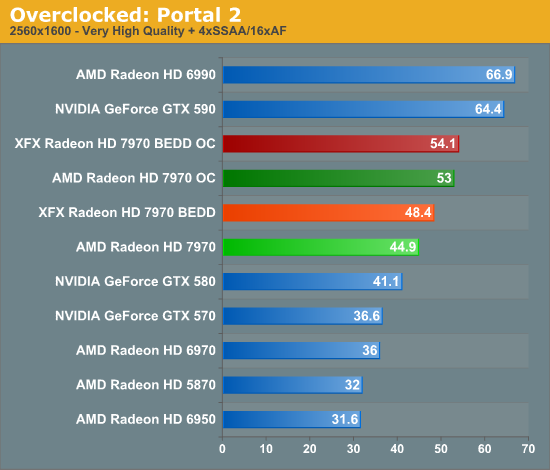
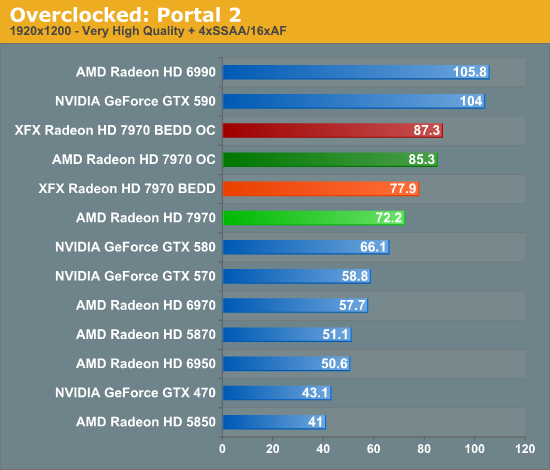
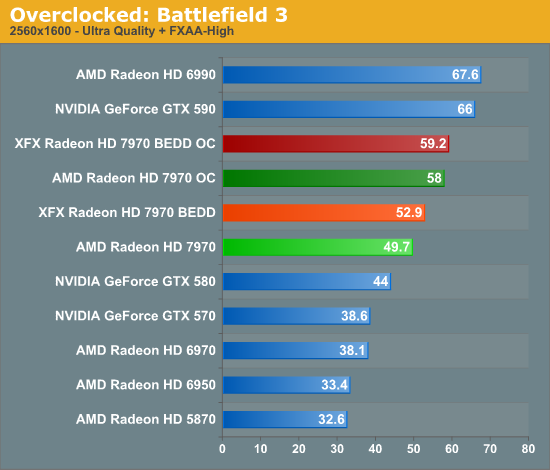
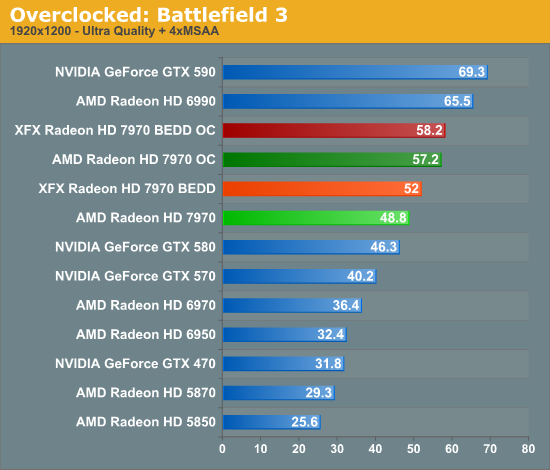
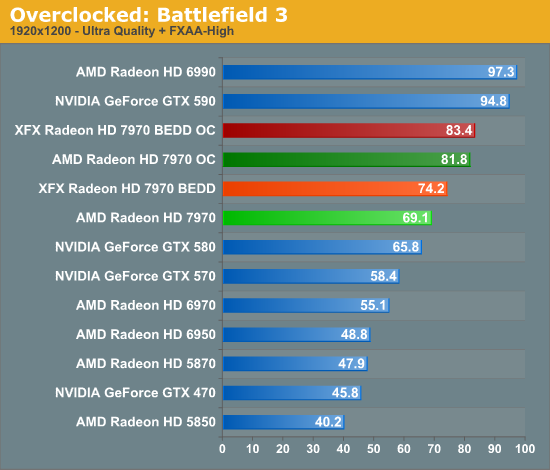
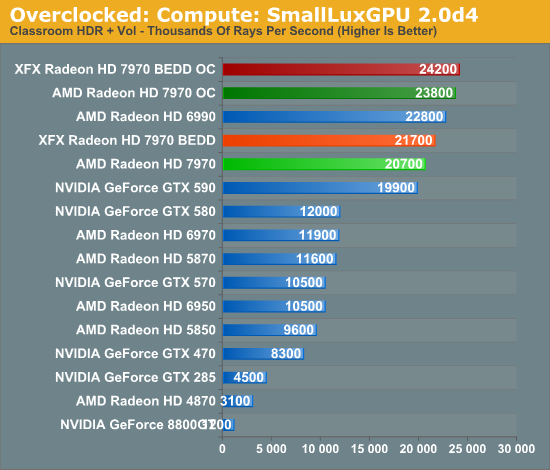
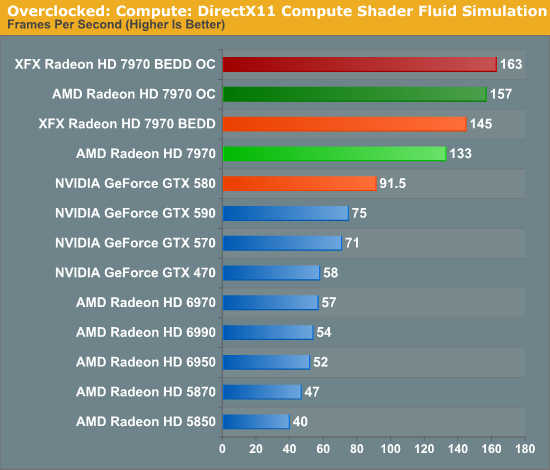
All things considered, outside of warranty restrictions there seems to be very little reason not to overclock the 7970 on its default voltage. Even a conservative overclock of 1050MHz would add 13% to the core clocks (and as a result performance in virtually all GPU-limited scenarios), which is a big enough leap in performance to justify spending the time setting up and testing the overclock. By not raising the core voltage there’s effectively no power/noise tradeoff and this seems to be achievable by virtually every 7970, making this a freebie overclock the likes of which we’re more accustomed to seeing on high-end CPUs than we are flagship GPUs.










47 Comments
View All Comments
CeriseCogburn - Saturday, June 23, 2012 - link
Yep Termie, now the hyper enthusiast experts with their 7970's are noobs unable to be skilled enough to overclock...Can you amd fans get together sometime and agree on your massive fudges once and for all - we just heard no one but the highest of all gamers and end user experts buys these cards - with the intention of overclocking the 7970 to the hilt, as the expert in them demands the most performance for the price...
We just heard MONTHS of that crap - now it's the opposite....
Suddenly, the $579.00 amd fanboy buyers can't overclock...
How about this one- add this one to the arsenal of hogwash...
" Don't void your warranty !" by overclocking even the tiniest bit..
( We know every amd fanboy will blow the crap out of their card screwing around and every tip given around the forums is how to fake out the vendor, lie, and get a free replacement after doing so )
darkswordsman17 - Tuesday, January 31, 2012 - link
First, sorry for this response being several days later.Fair enough. I didn't mean it as a real criticism just more of a nitpick. I realize the state of voltage control on video cards isn't exactly stellar and I'm sure AMD/nVidia aren't keen on you doing it.
Its certainly not as robust as CPU voltage adjustment is today, which I didn't mean to confuse as I understand there's a pretty significant disparity.
I sould have expanded my on my comment a bit more.I have a hunch AMD is being pretty conservative on voltage with these (in both directions, its higher than it needs to be, but its not as high as it could fairly safely be either). Firstly, probably to play it safe with the chips from the new process, but also I think they're giving themselves some breathing room for improvement. After 40nm, they probably didn't want to go for broke right out of the gate and leave some extra that they could push to improve as needed (they have space to release a 7980; something in line with the 4890). Considering the results, its not like they really need to, especially coupled with the rumored 28nm issues.
Oh, and likewise to Termie, I do still appreciate the work and realize you can't please everyone. I liked the update and actually I think you did enough to touch on the subject in the 7950 review (namely addressing the lack of quality software management for GPUs currently).
mczak - Friday, January 27, 2012 - link
The Leo demo as mentioned in the article has been released (no idea about version):http://developer.amd.com/samples/demos/pages/AMDRa...
Requires 7970 to run (not sure why exactly if it's just DirectX11/DirectCompute?).
mczak - Friday, January 27, 2012 - link
Actually Dave Baumann clarified it should run on other hw as well.ltcommanderdata - Friday, January 27, 2012 - link
It seemed like we've just finished seeing most major engines like Unreal Engine 3, FROSTBITE 2.0, CryEngine 3 transition to a deferred rendering model. Is it very difficult for developers to modify their existing/previous forward renderers to incorporate the new lighting technique used in the Leo Demo? Otherwise, given the investment developers have put into deferred rendering, I'm guessing they're not looking to transitioned back to an improved forward renderer anytime soon.On a related note, you mentioned the lack of MSAA is a common problem to DX10+. Given this improved lighting technique requires compute shaders, is it actually DX11 GPU only, ie. does it require CS5.0 or can it be implemented in CS4.x to support DX10 GPUs? According to the latest Steam survey, by far the majority of GPUs are still DX10, so game developers won't be dropping support for them for a few years. Some games do support DX11 only features like tessellation, but I presume that having to implement 2 different rendering/lighting models is a lot more work, which could hinder adoption if the technique isn't compatible with DX10 GPUs.
Logsdonb - Friday, January 27, 2012 - link
No one has tested the 7970 in a crossfire configuration under PCI 3.0. I would expect increased bandwidth to benefit the most in that environment. I realize the 7800 series will be better candidates for crossfire given price, heat, and power consumption but a test with the 7900 series would show the potential.piroroadkill - Friday, January 27, 2012 - link
I'm sorry, I might be pretty drunk, but I'm falling at the first page."PCIe Bandwidth..."
There's a clear difference between 8x and 16x PCIe 3.0
Even if it is small, it is there, showing some bottlenecking. If it was inside the margin of error, you'd expect they'd switch places. They didn't. There is clear bottlenecking.
Concillian - Friday, January 27, 2012 - link
I saw some stuff flying around about SMAA a month or two ago... seemed promising and a better alternative to FXAA, but I haven't seen much in the "official" media outlets about it.It'd be nice to see some analysis on SMAA vs. FXAA vs. Morphological AA in an article covering the current state of AA.
Ryan Smith - Friday, January 27, 2012 - link
As I understand it, SMAA is still a work in progress. It would be premature to comment on it at this time.tipoo - Friday, January 27, 2012 - link
If I remember correctly, TB provides the bandwidth of a PCIe 4x connection. So if a high end card like this isn't bottlenecked with that much constraint, it sure looks good for external graphics! You'd need a separate power plug of course, but it now looks feasible.